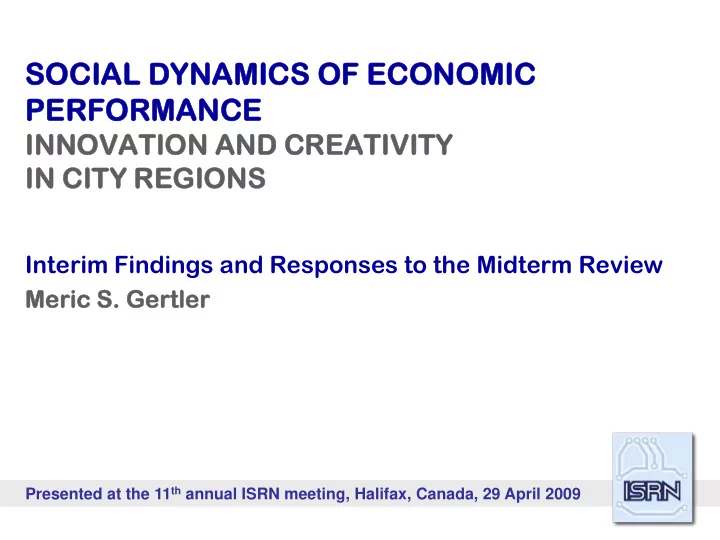

SOCIAL DYNAMICS OF ECONOMIC SOCIAL DYNAMICS OF ECONOMIC PERFORMANCE PERFORMANCE INNOVATION AND CREATIVITY INNOVATION AND CREATIVITY IN CITY REGIONS IN CITY REGIONS Interim Findings and Responses to the Midterm Review Meric S. Gertler Meric S. Gertler Presented at the 11 th annual ISRN meeting, Halifax, Canada, 29 April 2009 1
WHAT HAVE WE LEARNED SO FAR? • Social • Space • Specialization • Size • Civility 2
SOCIAL • Centrality of the social in every aspect – But takes on different meaning x theme • Social dynamics of learning, knowledge spillovers (density, concentration) in urban places • Social = cultural milieu • Social inclusion/exclusion – Concern about tendencies toward the latter – Open question: what influence do local institutions, governance have? 3
SPACE • Dichotomous? – Global-local; metropolis-hinterland • Or Continuous? (Rediscovery of relative location) • Location relative to large metro regions – Proximity to metros: blessing or curse? – Major centres offer specialized services; prosperity spills over to nearby mid-size and smaller communities – Larger neighbours may attract away scarce talent • Impact of intraurban spatial structure on social dynamics? 4
SPECIALIZATION • Related variety: innovation via knowledge circulation between sectors (Toronto biomed) • Specialization: ability to develop knowledge- intensive specializations determines growth (Waterloo vs Hamilton) • Specialization: resurgence (and collapse) of the Staples Economy • Open question: long-term resilience of S. Ontario economy? 5
SIZE • Easier for larger cities to develop multiple specializations (i.e. related variety linked to size) • Large cities: more likely to host sectors with best growth potential (knowledge-intensive)? • Large cities: amenity-rich, culturally diverse • Mid-size cities – If close to large ones, can also pursue similar path – Relational/governance advantages • Open question: independent effect or does size interact with other variables? 6
CIVILITY • Importance of mobilizing local civic resources, building within-class and cross-class, cross- stakeholder alliances to promote prosperity • If market forces are left unchecked, then the tendency toward social exclusion is strong • Local governance has potential to counter this tendency (Montreal case?) • Open question: prosperity with inclusion? – What are the characteristics of such a model? 7
RECOMMENDATIONS 1. The committee underlined the achievements of the team and the progress of the project in relation to the schedule presented in its original milestone document. The team must now focus on the integration of the project findings. Hence it strongly recommends that the Project Director and his team, in consultation with the Research Advisory Committee, develop strategies for integration. 8
RECOMMENDATIONS 2. The committee recommends developing a strategic framework for integrating and synthesizing the large amount of data collected thus far and the findings of various individual case studies. 3. The committee recommends that the Project Director organize a retreat solely devoted to the integration phase of the project. 9
RESPONSES • Production of synthesis papers: – D.A. Wolfe & A. Bramwell (2008) ‘Innovation, creativity and governance: social dynamics of economic performance in city-regions’, Innovation: Management, Policy & Practice , 10, 170-182. – D.A. Wolfe & J. Nelles (2009) ‘The strategic management of urban economies and the scope for intermunicipal cooperation: alternative approaches to economic development in Ontario’, Ontario in the Creative Age Working Paper Series, Martin Prosperity Institute, University of Toronto. – D.A. Wolfe (forthcoming 2009) monograph for Conference Board of Canada. 10
RESPONSES • Fall 2009 retreat for co-investigators to advance integration effort – One co-I from each city will be asked to prepare a paper synthesizing key findings for all three themes in their respective city – Retreat will focus on drawing out major findings arising from these syntheses – Identify further opportunities for collaborative synthesis papers 11
RESPONSES • Statistical analysis as an integrative tool – City-region database: now updated for 140 CMAs, CAs across Canada • 2006 Census results • USPTO data for Canadian patent holders – Survey of Innovation • Canadian CMAs (Vinodrai/Gertler) • Quebec urban regions (Shearmur) 12
RESPONSES • Restructure format of Halifax annual meeting – Reduce time devoted to presenting individual case study results – Focus sessions on core research questions – Emphasis on integrating across cases, around core questions and themes – Consult RAC on strategies for integration – Format tested (successfully) at ONRIS 2008 – Challenge: turning good case studies into good papers (that make more general points) 13
14 THANK YOU/MERCI • Suggestions welcome!
Recommend
More recommend